Ortiz de Montellano Paul R.(Ed.) Cytochrome P450. Structure, Mechanism, and Biochemistry
Подождите немного. Документ загружается.

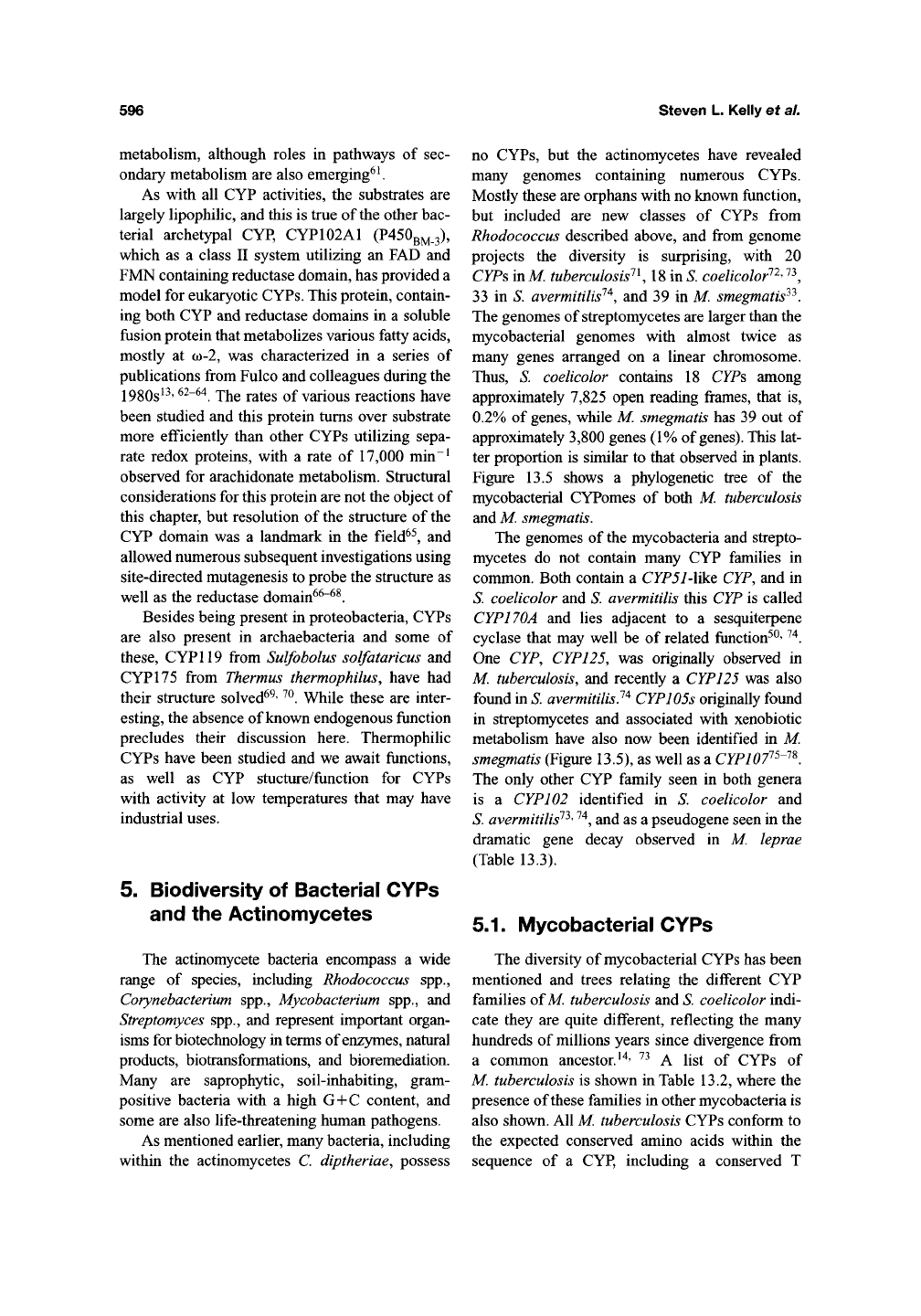
596
Steven L. Kelly et aL
metabolism, although roles
in
pathways
of
sec-
ondary metabolism
are
also emerging^ ^
As with
all CYP
activities,
the
substrates
are
largely lipophilic, and this
is
true of the other bac-
terial archetypal
CYP,
CYP102A1
(P450BJ^.3),
which
as a
class
II
system utilizing
an FAD and
FMN containing reductase domain, has provided
a
model
for
eukaryotic CYPs. This protein, contain-
ing both CYP
and
reductase domains
in a
soluble
fusion protein that metabolizes various fatty acids,
mostly
at (n-l, was
characterized
in a
series
of
publications from Fulco and colleagues during
the
1980s^^'
^^~^^.
The
rates
of
various reactions have
been studied
and
this protein turns over substrate
more efficiently than other CYPs utilizing sepa-
rate redox proteins, with
a
rate
of
17,000
min~^
observed
for
arachidonate metabolism. Structural
considerations
for
this protein are not the object
of
this chapter,
but
resolution
of
the structure
of
the
CYP domain
was a
landmark
in the
field^^,
and
allowed numerous subsequent investigations using
site-directed mutagenesis
to
probe
the
structure
as
well
as the
reductase domain^^"^^.
Besides being present
in
proteobacteria, CYPs
are also present
in
archaebacteria
and
some
of
these, CYP 119 from Sulfobolus solfataricus
and
CYP 175 from Thermus thermophilus, have
had
their structure solved^^' ^^. While these
are
inter-
esting,
the
absence of known endogenous function
precludes their discussion here. Thermophilic
CYPs have been studied
and we
await functions,
as well
as CYP
stucture/ftinction
for
CYPs
with activity
at low
temperatures that
may
have
industrial uses.
5. Biodiversity
of
Bacterial CYPs
and
the
Actinomycetes
The actinomycete bacteria encompass
a
wide
range
of
species, including Rhodococcus
spp.,
Corynebacterium
spp.,
Mycobacterium
spp., and
Streptomyces
spp., and
represent important organ-
isms for biotechnology in terms of enzymes, natural
products, biotransformations,
and
bioremediation.
Many
are
saprophytic, soil-inhabiting, gram-
positive bacteria with
a
high
G+C
content,
and
some
are
also life-threatening human pathogens.
As mentioned earlier, many bacteria, including
within
the
actinomycetes
C.
diptheriae, possess
no CYPs,
but the
actinomycetes have revealed
many genomes containing numerous CYPs.
Mostly these are orphans with no known ftinction,
but included
are new
classes
of
CYPs from
Rhodococcus described above,
and
from genome
projects
the
diversity
is
surprising, with
20
CYPs
inM
tuberculosis^^, 18 in
5.
coelicolor^-^'^^,
33
in
.S.
avermitilis^^,
and 39 in M
smegmatis^^.
The genomes
of
streptomycetes are larger than
the
mycobacterial genomes with almost twice
as
many genes arranged
on a
linear chromosome.
Thus,
S.
coelicolor contains
18
CZPs among
approximately 7,825 open reading frames, that
is,
0.2%
of
genes, while M. smegmatis
has 39 out of
approximately 3,800 genes
(1%
of
genes).
This lat-
ter proportion
is
similar
to
that observed
in
plants.
Figure
13.5
shows
a
phylogenetic tree
of the
mycobacterial CYPomes
of
both
M.
tuberculosis
and
M.
smegmatis.
The genomes
of
the mycobacteria
and
strepto-
mycetes
do not
contain many
CYP
families
in
common. Both contain
a
CYP51-like CYP,
and in
S.
coelicolor
and
S. avermitilis this CYP
is
called
CYP170A
and
lies adjacent
to a
sesquiterpene
cyclase that
may
well
be of
related
ftinction^^'
^^.
One
CYP,
CYP125,
was
originally observed
in
M.
tuberculosis,
and
recently
a
CYP125
was
also
found in
S.
avermitilis?"^
CYP 105s originally found
in streptomycetes
and
associated with xenobiotic
metabolism have also
now
been identified
in M
smegmatis (Figure 13.5),
as
well
as a
CYP107^^~^^.
The only other
CYP
family seen
in
both genera
is
a
CYP 102 identified
in S.
coelicolor
and
S.
avermitilis^^'
'^^,
and
as a
pseudogene seen
in the
dramatic gene decay observed
in M
leprae
(Table 13.3).
5.1.
Mycobacterial CYPs
The diversity
of
mycobacterial CYPs
has
been
mentioned
and
trees relating
the
different
CYP
families of M tuberculosis
and
S.
coelicolor indi-
cate they
are
quite different, reflecting
the
many
hundreds
of
millions years since divergence from
a conamon
ancestor.
^'*'
^^ A
list
of
CYPs
of
M tuberculosis
is
shown
in
Table 13.2, where
the
presence of these families
in
other mycobacteria
is
also shown. All
M
tuberculosis CYPs conform
to
the expected conserved amino acids within
the
sequence
of a CYP,
including
a
conserved
T
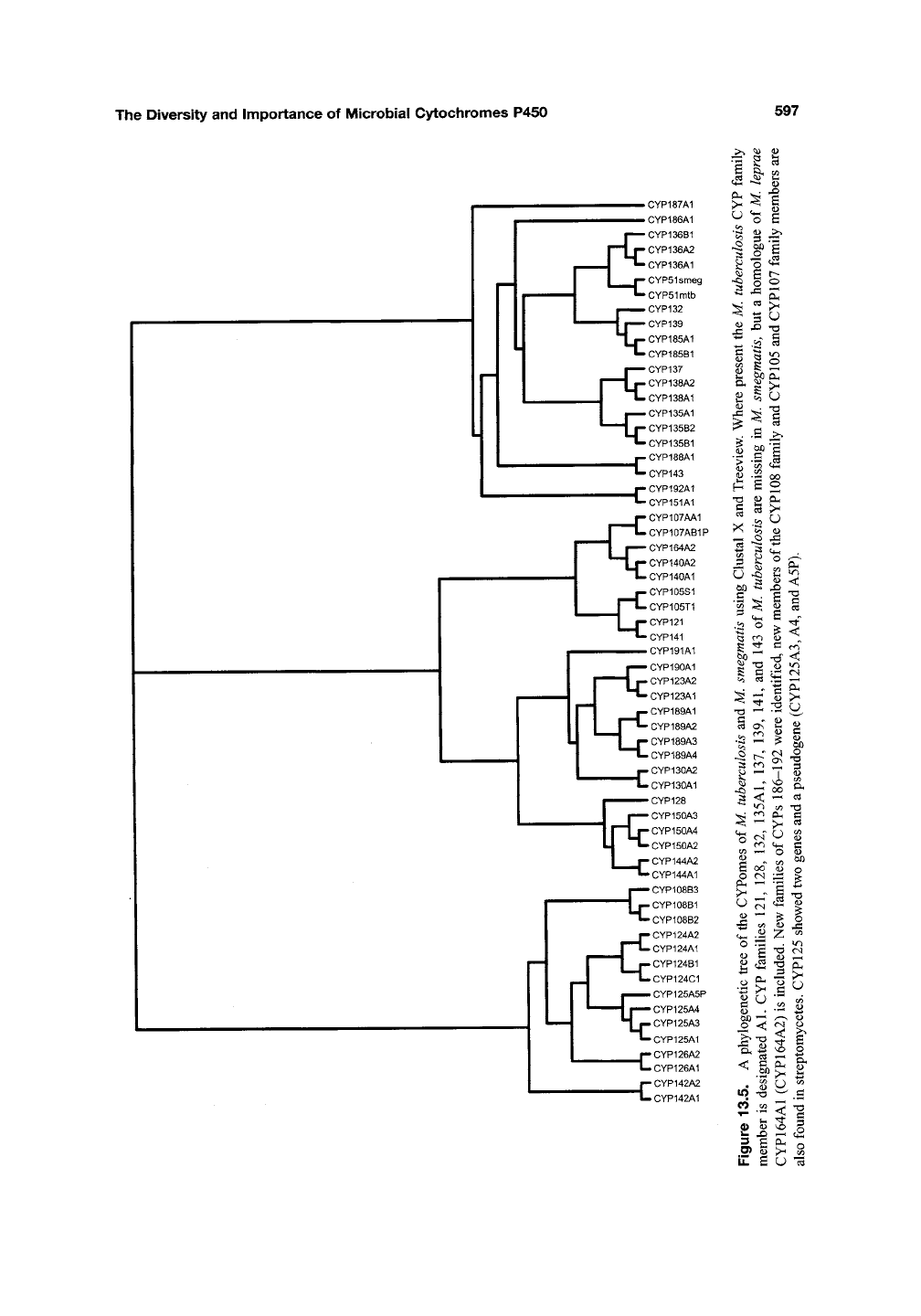
The
Diversity
and
Importance
of
Microbial Cytochromes P450
597
^
-CYP187A1
-
CYP186A1
CYP136B1
CYP136A2
CYP136A1
I
I
pCYP51smeg
L.cYP51mtb
•^
^
r^
^
CYP132
CYP139
CYP185A1
CYP185B1
CYP137
CYP138A2
CYP138A1
CYP135A1
CYP135B2
CYP135B1
CYP188A1
CYP143
CYP192A1
CYP151A1
CYP107AA1
CYP107AB1P
CYP164A2
CYP140A2
CYP140A1
CYP105S1
CYP105T1
CYP121
CYP141
CYP191A1
CYP190A1
CYP123A2
CYP123A1
CYP189A1
CYP189A2
CYP189A3
CYP189A4
CYP130A2
CYP130A1
CYP128
CYP150A3
CYP150A4
CYP150A2
CYP144A2
CYP144A1
CYP108B3
CYP108B1
CYP108B2
CYP124A2
CYP124A1
CYP124B1
CYP124C1
CYP125A5P
CYP125A4
CYP125A3
CYP125A1
CYP126A2
CYP126A1
CYP142A2
CYP142A1
1
2
^ s
o B
o o
^3
^
B o
X
1^
i !
^+-
_3i ^
2 3 U
^3
-Ci --^ 00 ^
^2
OH
::!
I I
z
g U
111
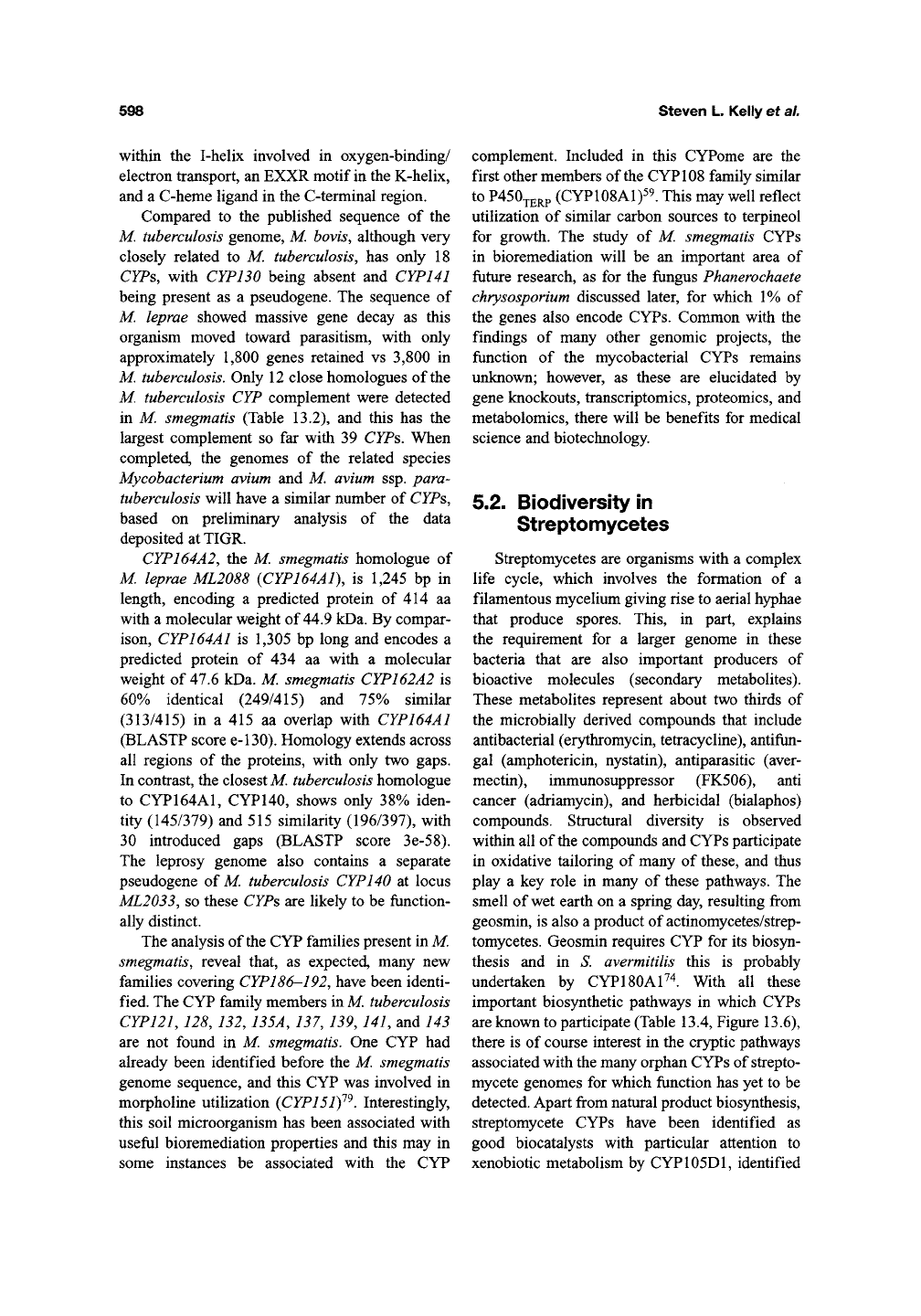
598
Steven
L.
Kelly
et al.
within the I-hehx involved in oxygen-binding/
electron transport, an EXXR motif in the K-helix,
and a C-heme ligand in the C-terminal region.
Compared to the published sequence of the
M tuberculosis genome, M
bovis^
although very
closely related to M tuberculosis, has only 18
CYPs, with CYP130 being absent and CYP141
being present as a pseudogene. The sequence of
M. leprae showed massive gene decay as this
organism moved toward parasitism, with only
approximately 1,800 genes retained vs 3,800 in
M tuberculosis. Only 12 close homologues of the
M tuberculosis CYP complement were detected
in M smegmatis (Table 13.2), and this has the
largest complement so far with 39 CYPs. When
completed, the genomes of the related species
Mycobacterium avium and M avium ssp. para-
tuberculosis will have a similar number of CYPs,
based on preliminary analysis of the data
deposited at TIGR.
CYP164A2, the M smegmatis homologue of
M leprae ML2088 (CYP164A1), is 1,245 bp in
length, encoding a predicted protein of 414 aa
with a molecular weight of
44.9
kDa. By compar-
ison, CYP 164A1 is 1,305 bp long and encodes a
predicted protein of 434 aa with a molecular
weight of 47.6 kDa. M. smegmatis CYP162A2 is
60%
identical (249/415) and 75% similar
(313/415) in a 415 aa overlap with CYP164A1
(BLASTP score e-130). Homology extends across
all regions of the proteins, with only two gaps.
In contrast, the closest M tuberculosis homologue
to CYP164A1, CYP140, shows only 38% iden-
tity (145/379) and 515 similarity (196/397), with
30 introduced gaps (BLASTP score 3e-58).
The leprosy genome also contains a separate
pseudogene of M tuberculosis CYP 140 at locus
ML2033, so these CYPs are likely to be function-
ally distinct.
The analysis of the CYP families present in M
smegmatis, reveal that, as expected, many new
families covering CYP186-192, have been identi-
fied. The CYP family members in
M.
tuberculosis
CYP121,
128, 132,135A, 137, 139,141, and 143
are not found in M smegmatis. One CYP had
already been identified before the M. smegmatis
genome sequence, and this CYP was involved in
morpholine utilization (CYP15iy^. Interestingly,
this soil microorganism has been associated with
useful bioremediation properties and this may in
some instances be associated with the CYP
complement. Included in this CYPome are the
first other members of the CYP 108 family similar
to
P450TERP
(CYP108A1)5^ This may well reflect
utilization of similar carbon sources to terpineol
for growth. The study of M smegmatis CYPs
in bioremediation will be an important area of
future research, as for the fungus Phanerochaete
chrysosporium discussed later, for which 1% of
the genes also encode CYPs. Common with the
findings of many other genomic projects, the
function of the mycobacterial CYPs remains
unknown; however, as these are elucidated by
gene knockouts, transcriptomics, proteomics, and
metabolomics, there will be benefits for medical
science and biotechnology.
5.2. Biodiversity in
Streptomycetes
Streptomycetes are organisms with a complex
life cycle, which involves the formation of a
filamentous mycelium giving rise to aerial hyphae
that produce spores. This, in part, explains
the requirement for a larger genome in these
bacteria that are also important producers of
bioactive molecules (secondary metabolites).
These metabolites represent about two thirds of
the microbially derived compounds that include
antibacterial (erythromycin, tetracycline), antifun-
gal (amphotericin, nystatin), antiparasitic (aver-
mectin), immunosuppressor (FK506), anti
cancer (adriamycin), and herbicidal (bialaphos)
compounds. Structural diversity is observed
within all of the compounds and CYPs participate
in oxidative tailoring of many of these, and thus
play a key role in many of these pathways. The
smell of wet earth on a spring day, resulting from
geosmin, is also a product of actinomycetes/strep-
tomycetes. Geosmin requires CYP for its biosyn-
thesis and in S. avermitilis this is probably
undertaken by CYP 180A 1^1 With all these
important biosynthetic pathways in which CYPs
are known to participate (Table 13.4, Figure 13.6),
there is of course interest in the cryptic pathways
associated with the many orphan CYPs of strepto-
mycete genomes for which function has yet to be
detected. Apart from natural product biosynthesis,
streptomycete CYPs have been identified as
good biocatalysts with particular attention to
xenobiotic metabolism by CYP105D1, identified
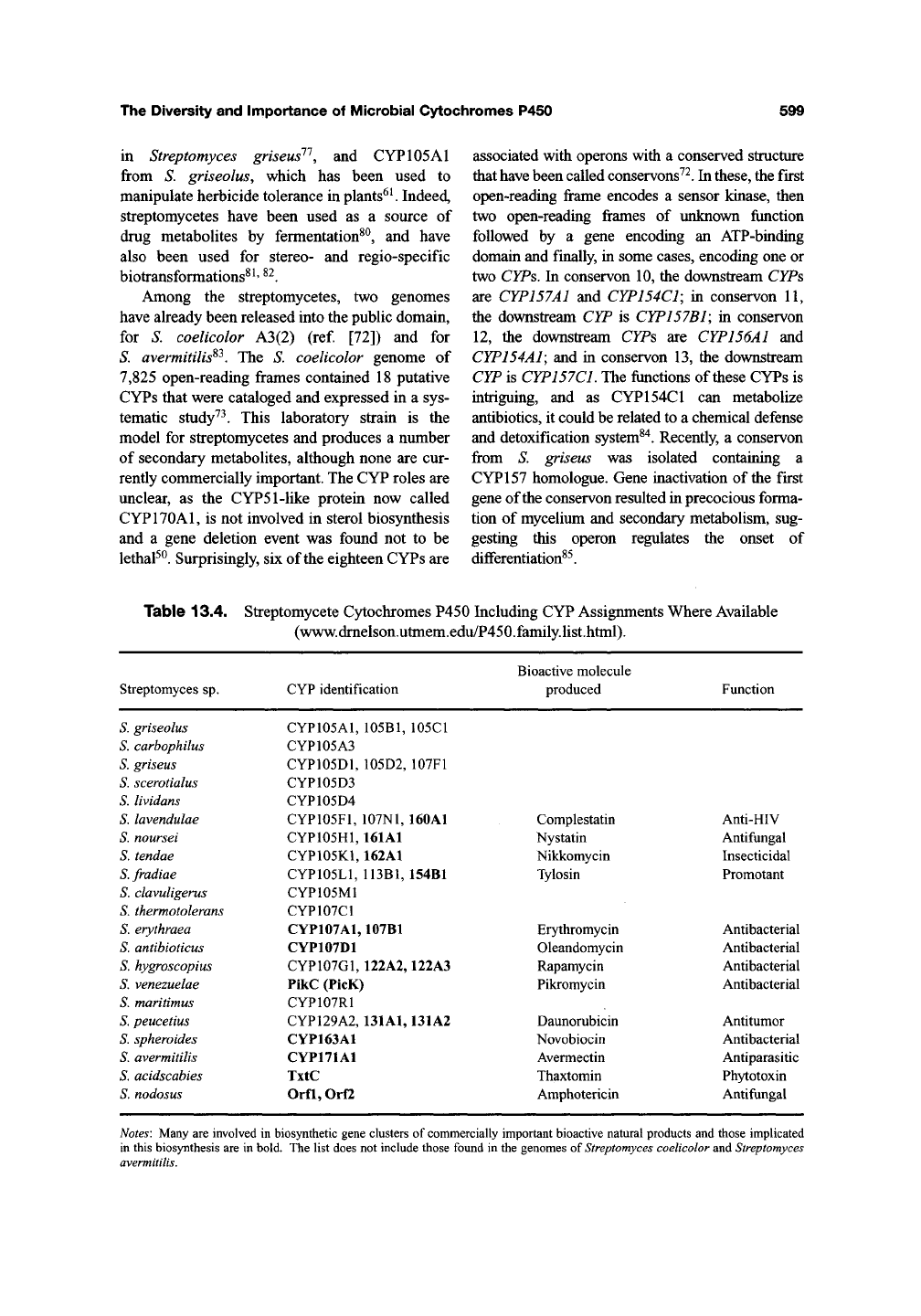
The Diversity and Importance of Microbial Cytochromes P450
599
in Streptomyces griseus^^, and CYP105A1
from S. griseolus, which has been used to
manipulate herbicide tolerance in plants^ ^ Indeed,
streptomycetes have been used as a source of
drug metabolites by fermentation^^, and have
also been used for stereo- and regio-specific
biotransformations^^' ^^.
Among the streptomycetes, two genomes
have already been released into the public domain,
for S. coelicolor A3(2) (ref [72]) and for
S. avermitilis^^. The S. coelicolor genome of
7,825
open-reading frames contained 18 putative
CYPs that were cataloged and expressed in a sys-
tematic study^^. This laboratory strain is the
model for streptomycetes and produces a number
of secondary metabolites, although none are cur-
rently commercially important. The CYP roles are
unclear, as the
CYPS
1-like
protein now called
CYP170A1,
is not involved in sterol biosynthesis
and a gene deletion event was found not to be
lethal^^. Surprisingly, six of the eighteen CYPs are
associated with operons with a conserved structure
that
have
been called
conservons^^.
In
these,
the first
open-reading frame encodes a sensor kinase, then
two open-reading frames of unknown ftinction
followed by a gene encoding an ATP-binding
domain and finally, in some cases, encoding one or
two CYPs. In conservon 10, the downstream CYPs
are CYP157A1 and CYP154C1; in conservon 11,
the downstream CYP is CYP157B1; in conservon
12,
the downstream CYPs are CYP156A1 and
CYP154A1;
and in conservon 13, the downstream
CYP is CYP157CL The frmctions of these CYPs is
intriguing, and as CYP154C1 can metabolize
antibiotics, it could be related to a chemical defense
and detoxification system^"^. Recently, a conservon
from S. griseus was isolated containing a
CYP 157 homologue. Gene inactivation of the first
gene of the conservon resulted in precocious forma-
tion of mycelium and secondary metabolism, sug-
gesting this operon regulates the onset of
differentiation^^.
Table 13.4.
Streptomyces sp.
S, griseolus
S. carbophilus
S. griseus
S. scerotialus
S. lividans
S. lavendulae
S. noursei
S. tendae
S.
fradiae
S. clavuligerus
S. thermotolerans
S. erythraea
S. antibioticus
S. hygroscopius
S. venezuelae
S. maritimus
S. peucetius
S. spheroides
S. avermitilis
S. acidscabies
S. nodosus
Streptomycete Cytochromes P450 Including CYP Assignments
(www.dmelson.utmem.edu/P450.family.list.html).
CYP identification
CYP105A1,
105B1,
105C1
CYP105A3
CYP105D1,
105D2, 107F1
CYP105D3
CYP105D4
CYP105F1,
107N1,160A1
CYP105H1,161A1
CYP105K1,162A1
CYP105L1,
113B1,154B1
CYP105M1
CYP107C1
CYP107A1,107B1
CYP107D1
CYP107G1,
122A2,122A3
PikC (PicK)
CYP107R1
CYP129A2, 131A1,131A2
CYP163A1
CYP171A1
TxtC
Orfl, Orf2
Bioactive molecule
produced
Complestatin
Nystatin
Nikkomycin
Tylosin
Erythromycin
Oleandomycin
Rapamycin
Pikromycin
Daunorubicin
Novobiocin
Avermectin
Thaxtomin
Amphotericin
Where Available
Function
Anti-HIV
Antifungal
Insecticidal
Promotant
Antibacterial
Antibacterial
Antibacterial
Antibacterial
Antitumor
Antibacterial
Antiparasitic
Phytotoxin
Antifungal
Notes: Many are involved in biosynthetic gene clusters of commercially important bioactive natural products and those implicated
in this biosynthesis are in bold. The list does not include those found in the genomes of Streptomyces coelicolor and Streptomyces
avermitilis.
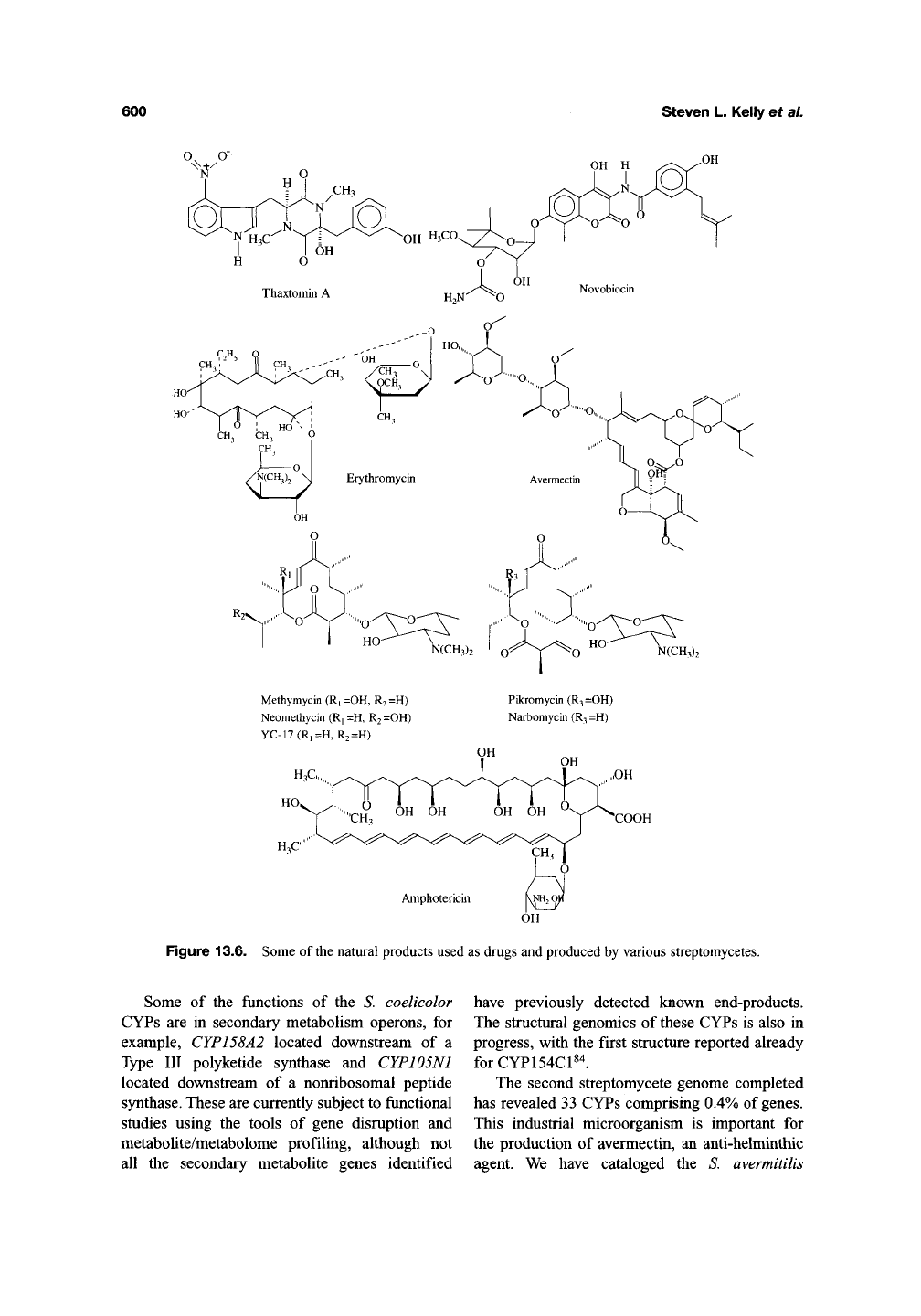
600
Steven L. Kelly et al.
HO''
O N(CH3)2
Methymycin (Ri=OH, R2=H)
Neomethycin (Rj =H, R2=OH)
YC-17(Ri=H, R2=H)
Pikromycin(R3=OH)
Narbomycin (R3 =H)
OH
H3C"
Amphotericin
Figure 13.6. Some of the natural products used as drugs and produced by various streptomycetes.
Some of the functions of the S. coelicolor
CYPs are in secondary metabohsm operons, for
example, CYP158A2 located downstream of a
Type III polyketide synthase and CYP105N1
located downstream of a nonribosomal peptide
synthase. These are currently subject to functional
studies using the tools of gene disruption and
metabolite/metabolome profiling, although not
all the secondary metabolite genes identified
have previously detected known end-products.
The structural genomics of these CYPs is also in
progress, with the first structure reported already
forCYP154Cl81
The second streptomycete genome completed
has revealed 33 CYPs comprising 0.4% of genes.
This industrial microorganism is important for
the production of avermectin, an anti-helminthic
agent. We have cataloged the S. avermitilis
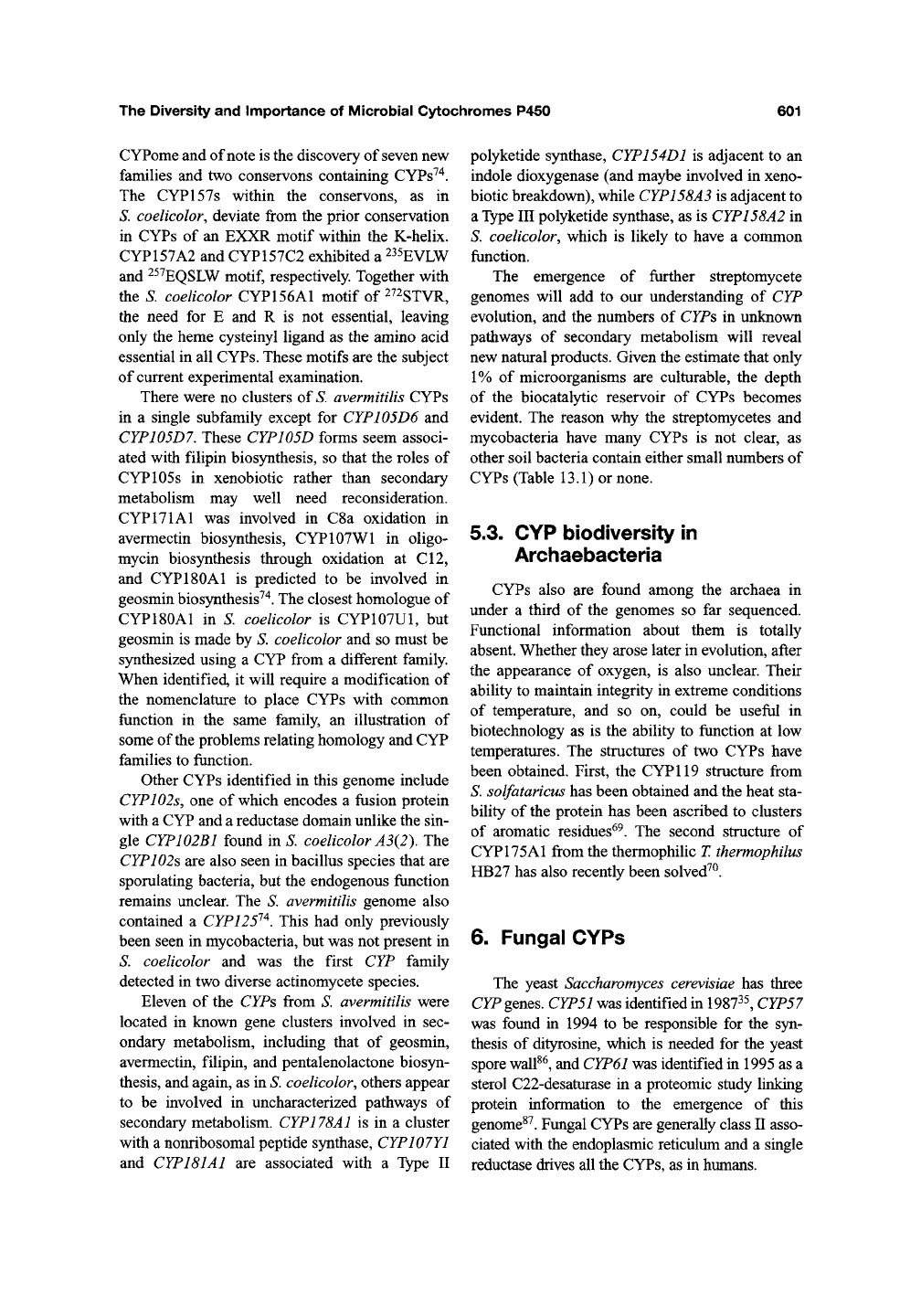
The Diversity and Importance of IN^icrobial Cytochromes P450
601
CYPome and of note is the discovery of seven new
families and two conservons containing CYPs^"^.
The CYP157s within the conservons, as in
S. coelicolor, deviate from the prior conservation
in CYPs of an EXXR motif within the K-hehx.
CYP157A2 and CYP157C2 exhibited a
^^^ENYSSf
and ^^^EQSLW
motif,
respectively. Together with
the 5. coelicolor CYP156A1 motif of 272STVR,
the need for E and R is not essential, leaving
only the heme cysteinyl ligand as the amino acid
essential in all CYPs. These motifs are the subject
of current experimental examination.
There were no clusters of
S.
avermitilis CYPs
in a single subfamily except for CYP105D6 and
CYP105D7. These CYP105D forms seem associ-
ated with filipin bios)aithesis, so that the roles of
CYPlOSs in xenobiotic rather than secondary
metabolism may well need reconsideration.
CYP171A1 was involved in C8a oxidation in
avermectin biosynthesis, CYP107W1 in oligo-
mycin biosynthesis through oxidation at C12j
and CYP180A1 is predicted to be involved in
geosmin biosynthesis^'*. The closest homologue of
CYP180A1 in S. coelicolor is CYP107U1, but
geosmin is made by S. coelicolor and so must be
S5mthesized using a CYP from a different family.
When identified, it will require a modification of
the nomenclature to place CYPs with common
function in the same family, an illustration of
some of the problems relating homology and CYP
families to function.
Other CYPs identified in this genome include
CYP 102s, one of which encodes a fusion protein
with a CYP and a reductase domain unlike the sin-
gle CYP102B1 found in S. coelicolor A3(2). The
CYP 102s are also seen in bacillus species that are
sporulating bacteria, but the endogenous function
remains unclear. The S. avermitilis genome also
contained a CYP 125^^. This had only previously
been seen in mycobacteria, but was not present in
S. coelicolor and was the first CYP family
detected in two diverse actinomycete species.
Eleven of the CYPs from S. avermitilis were
located in known gene clusters involved in sec-
ondary metabolism, including that of geosmin,
avermectin, filipin, and pentalenolactone biosyn-
thesis,
and again, as in
S.
coelicolor, others appear
to be involved in uncharacterized pathways of
secondary metabolism. CYP 178A1 is in a cluster
with a nonribosomal peptide synthase, CYP107Y1
and CYP 181 Al are associated with a Type II
polyketide synthase, CYP154D1 is adjacent to an
indole dioxygenase (and maybe involved in xeno-
biotic breakdown), while CYP158A3 is adjacent to
a Type III polyketide synthase, as is CYP158A2 in
S. coelicolor, which is likely to have a common
function.
The emergence of further streptomycete
genomes will add to our understanding of CYP
evolution, and the numbers of CYPs in unknown
pathways of secondary metabolism will reveal
new natural products. Given the estimate that only
1%
of microorganisms are culturable, the depth
of the biocatal3^ic reservoir of CYPs becomes
evident. The reason why the streptomycetes and
mycobacteria have many CYPs is not clear, as
other soil bacteria contain either small numbers of
CYPs (Table 13.1) or none.
5-3. CYP biodiversity in
Archaebacteria
CYPs also are found among the archaea in
under a third of the genomes so far sequenced.
Functional information about them is totally
absent. Whether they arose later in evolution, after
the appearance of oxygen, is also unclear. Their
ability to maintain integrity in extreme conditions
of temperature, and so on, could be useful in
biotechnology as is the ability to function at low
temperatures. The structures of two CYPs have
been obtained. First, the CYP119 structure from
S. solfataricus has been obtained and the heat sta-
bility of the protein has been ascribed to clusters
of aromatic residues^^. The second structure of
CYP 175A1 from the thermophilic
T.
thermophilus
HB27 has also recently been solved^^.
6. Fungal CYPs
The yeast Saccharomyces cerevisiae has three
CYP
genes.
CYP51
was identified in 1987^^ CYP57
was found in 1994 to be responsible for the syn-
thesis of dityrosine, which is needed for the yeast
spore
wall^^,
and
CYP61
was identified in 1995 as a
sterol C22-desaturase in a proteomic study linking
protein information to the emergence of this
genome^^. Fungal CYPs are generally class II asso-
ciated with the endoplasmic reticulum and a single
reductase drives all the CYPs, as in humans.
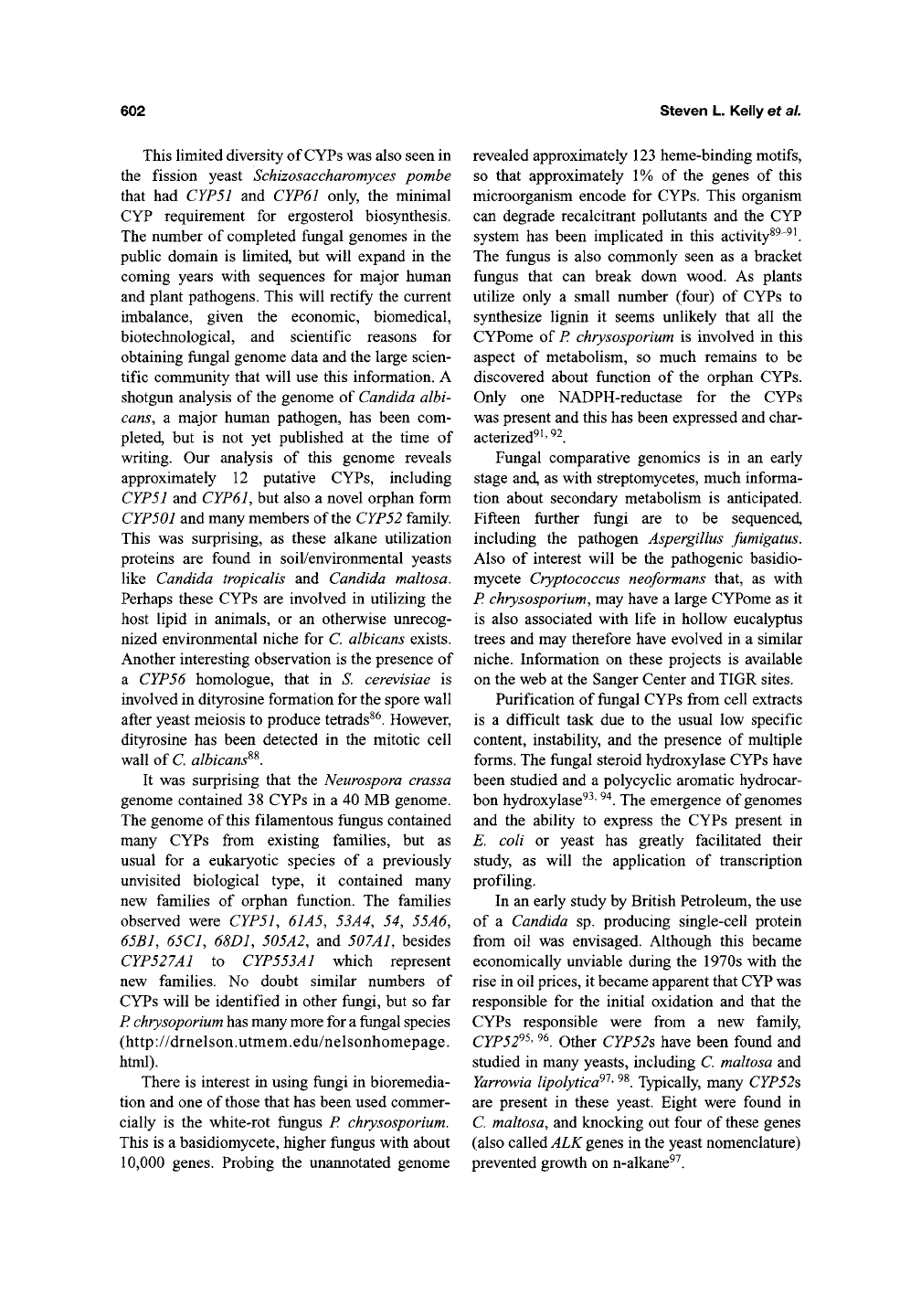
602
Steven L. Kelly et al.
This limited diversity of CYPs was also seen in
the fission yeast Schizosaccharomyces pombe
that had CYP51 and CYP61 only, the minimal
CYP requirement for ergosterol biosynthesis.
The number of completed fungal genomes in the
public domain is limited, but will expand in the
coming years with sequences for major human
and plant pathogens. This will rectify the current
imbalance, given the economic, biomedical,
biotechnological, and scientific reasons for
obtaining fungal genome data and the large scien-
tific community that will use this information. A
shotgun analysis of the genome of Candida albi-
cans, a major human pathogen, has been com-
pleted, but is not yet published at the time of
writing. Our analysis of this genome reveals
approximately 12 putative CYPs, including
CYP51 and CYP61, but also a novel orphan form
CYP501 and many members of the CYP52 family.
This was surprising, as these alkane utilization
proteins are found in soil/environmental yeasts
like Candida tropicalis and Candida maltosa.
Perhaps these CYPs are involved in utilizing the
host lipid in animals, or an otherwise unrecog-
nized environmental niche for C. albicans exists.
Another interesting observation is the presence of
a CYP56 homologue, that in S. cerevisiae is
involved in dityrosine formation for the spore wall
after yeast meiosis to produce tetrads^^. However,
dityrosine has been detected in the mitotic cell
wall of C albicans^^.
It was surprising that the Neurospora crassa
genome contained 38 CYPs in a 40 MB genome.
The genome of this filamentous fungus contained
many CYPs from existing families, but as
usual for a eukaryotic species of a previously
unvisited biological type, it contained many
new families of orphan function. The families
observed were CYP5U 61A5, 53A4, 54, 55A6,
65B1,
65C1, 68D1, 505A2, and 507A1, besides
CYP527A1 to CYP553A1 which represent
new families. No doubt similar numbers of
CYPs will be identified in other fungi, but so far
P chrysoporium has many more for a fungal species
(http://drnelson.utmem.edu/nelsonhomepage.
html).
There is interest in using fungi in bioremedia-
tion and one of those that has been used commer-
cially is the white-rot fungus P. chrysosporium.
This is a basidiomycete, higher fungus with about
10,000 genes. Probing the unannotated genome
revealed approximately 123 heme-binding motifs,
so that approximately 1% of the genes of this
microorganism encode for CYPs. This organism
can degrade recalcitrant pollutants and the CYP
system has been implicated in this activity^^"^^
The fungus is also commonly seen as a bracket
fungus that can break down wood. As plants
utilize only a small number (four) of CYPs to
synthesize lignin it seems unlikely that all the
CYPome of
P.
chrysosporium is involved in this
aspect of metabolism, so much remains to be
discovered about function of the orphan CYPs.
Only one NADPH-reductase for the CYPs
was present and this has been expressed and char-
acterized^^'^^.
Fungal comparative genomics is in an early
stage and, as with streptomycetes, much informa-
tion about secondary metabolism is anticipated.
Fifteen further fiangi are to be sequenced,
including the pathogen Aspergillus fumigatus.
Also of interest will be the pathogenic basidio-
mycete Cryptococcus neoformans that, as with
P chrysosporium, may have a large CYPome as it
is also associated with life in hollow eucalyptus
trees and may therefore have evolved in a similar
niche. Information on these projects is available
on the web at the Sanger Center and TIGR sites.
Purification of fungal CYPs from cell extracts
is a difficult task due to the usual low specific
content, instability, and the presence of multiple
forms.
The fungal steroid hydroxylase CYPs have
been studied and a polycyclic aromatic hydrocar-
bon hydroxylase^^'
^^.
The emergence of genomes
and the ability to express the CYPs present in
E. coli or yeast has greatly facilitated their
study, as will the application of transcription
profiling.
In an early study by British Petroleum, the use
of a Candida sp. producing single-cell protein
from oil was envisaged. Although this became
economically unviable during the 1970s with the
rise in oil prices, it became apparent that CYP was
responsible for the initial oxidation and that the
CYPs responsible were from a new family,
CYP52^^^
96
Other CYP52s have been found and
studied in many yeasts, including C. maltosa and
Yarrowia
lipolytica^^'
^^.
Typically, many CYP52s
are present in these yeast. Eight were found in
C. maltosa, and knocking out four of these genes
(also called ALK genes in the yeast nomenclature)
prevented growth on n-alkane^^.
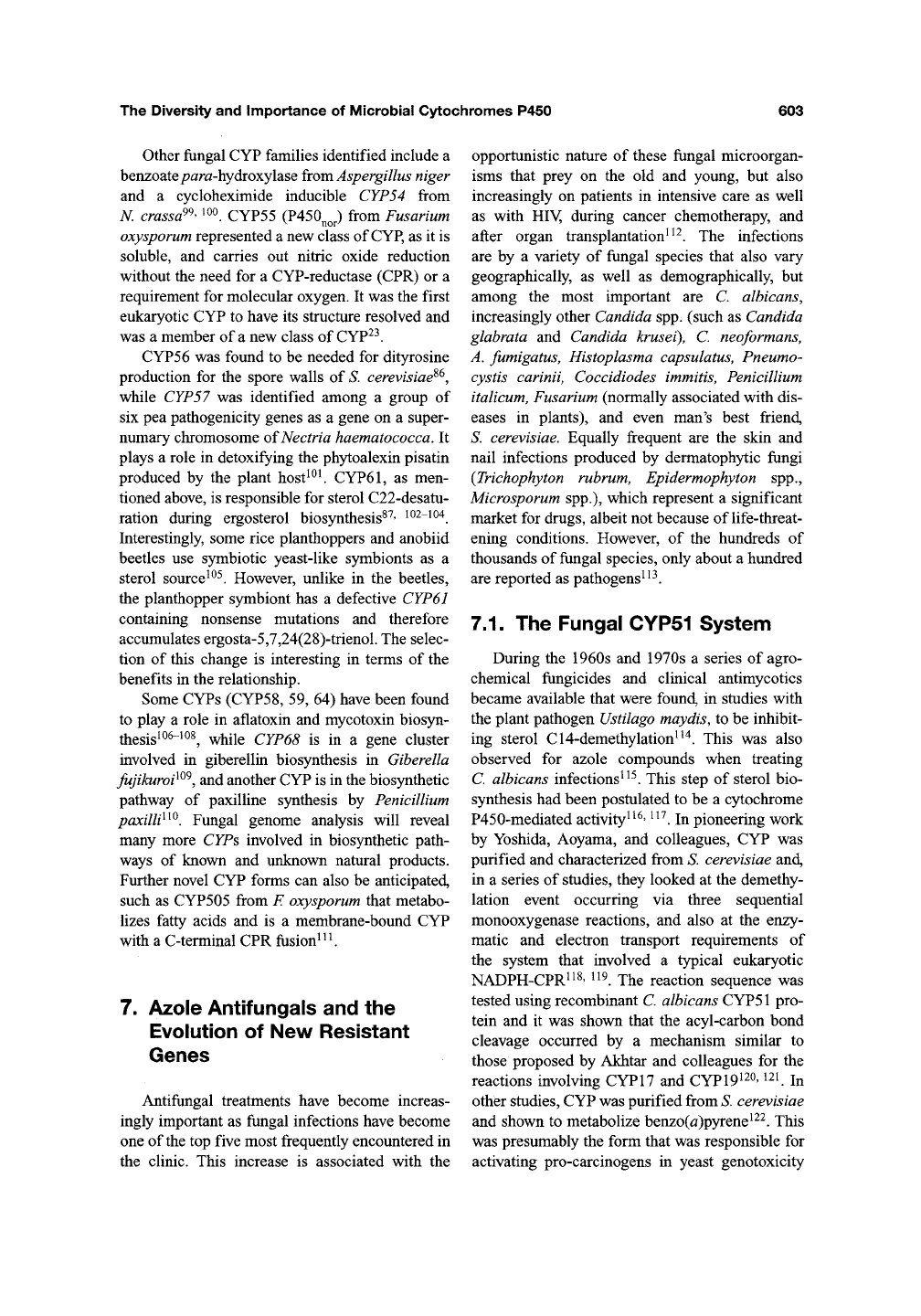
The Diversity and Importance of IVIicrobial Cytochromes P450
603
Other fungal CYP families identified include a
benzoate/7fl!ra-hydroxylase from Aspergillus niger
and a cycloheximide inducible CYP54 from
N.
crassa^"^^
^^^.
CYP55
(P450^
J from Fusarium
oxysporum represented a new class of
CYP,
as it is
soluble, and carries out nitric oxide reduction
without the need for a CYP-reductase (CPR) or a
requirement for molecular oxygen. It was the first
eukaryotic CYP to have its structure resolved and
was a member of a new class of
CYP^^.
CYP56 was found to be needed for dityrosine
production for the spore walls of
S.
cerevisiae^^,
while CYP5 7 was identified among a group of
six pea pathogenicity genes as a gene on a super-
numary chromosome of Nectria haematococca. It
plays a role in detoxifying the phytoalexin pisatin
produced by the plant host^^^
CYP61,
as men-
tioned above, is responsible for sterol C22-desatu-
ration during ergosterol biosynthesis^^' 102-104
Interestingly, some rice planthoppers and anobiid
beetles use symbiotic yeast-like symbionts as a
sterol source ^^^. However, unlike in the beetles,
the planthopper symbiont has a defective CYP61
containing nonsense mutations and therefore
accumulates ergosta-5,7,24(28)-trienoL The selec-
tion of this change is interesting in terms of the
benefits in the relationship.
Some CYPs (CYP58, 59, 64) have been found
to play a role in aflatoxin and mycotoxin biosyn-
thesislo^^^^ while CYP68 is in a gene cluster
involved in giberellin biosynthesis in Giberella
fujikuroi^^^, and another CYP is in the biosynthetic
pathway of paxilline synthesis by Penicillium
paxilli^^^. Fungal genome analysis will reveal
many more CYPs involved in biosynthetic path-
ways of known and unknown natural products.
Further novel CYP forms can also be anticipated,
such as CYP505 from E oxysporum that metabo-
lizes fatty acids and is a membrane-bound CYP
with a C-terminal CPR fusion^ ^ ^
7. Azole Antifungals and the
Evolution of New Resistant
Genes
Antifungal treatments have become increas-
ingly important as fungal infections have become
one of the top five most frequently encountered in
the clinic. This increase is associated with the
opportunistic nature of these fungal microorgan-
isms that prey on the old and young, but also
increasingly on patients in intensive care as well
as with HIV, during cancer chemotherapy, and
after organ transplantation^
^^.
The infections
are by a variety of fungal species that also vary
geographically, as well as demographically, but
among the most important are C. albicans,
increasingly other Candida spp. (such as Candida
glabrata and Candida krusei), C neoformans,
A.
fumigatus, Histoplasma capsulatus, Pneumo-
cystis carina, Coccidiodes immitis, Penicillium
italicum, Fusarium (normally associated with dis-
eases in plants), and even man's best friend,
S. cerevisiae. Equally frequent are the skin and
nail infections produced by dermatophytic fungi
(Trichophyton rubrum, Epidermophyton spp.,
Microsporum spp.), which represent a significant
market for drugs, albeit not because of life-threat-
ening conditions. However, of the hundreds of
thousands of fungal species, only about a hundred
are reported as pathogens^^^.
7.1.
The Fungal CYP51 System
During the 1960s and 1970s a series of agro-
chemical fiingicides and clinical antimycotics
became available that were found, in studies with
the plant pathogen Ustilago maydis, to be inhibit-
ing sterol CH-demethylation^^"^. This was also
observed for azole compounds when treating
C. albicans infections^^^. This step of sterol bio-
synthesis had been postulated to be a cytochrome
P450-mediated activity^
^^' ^^^.
In pioneering work
by Yoshida, Aoyama, and colleagues, CYP was
purified and characterized from S. cerevisiae and,
in a series of studies, they looked at the demethy-
lation event occurring via three sequential
monooxygenase reactions, and also at the enzy-
matic and electron transport requirements of
the system that involved a typical eukaryotic
NADPH-CPRii^' 119. The reaction sequence was
tested using recombinant C albicans CYP51 pro-
tein and it was shown that the acyl-carbon bond
cleavage occurred by a mechanism similar to
those proposed by Akhtar and colleagues for the
reactions involving CYP17 and CYPI9120,121. in
other studies, CYP was purified from S. cerevisiae
and shown to metabolize benzo((3)pyrenei^^. This
was presumably the form that was responsible for
activating pro-carcinogens in yeast genotoxicity

604
Steven L. Kelly et al.
HO''
Eburicol
Ergosterol
HO'
14-methylfecoster ol
C5,6-desaturase
HO''
14-methyl-3,6-diol
Figure 13.7. The sterols accumulating under azole treatment of C. albicans including the end-product, 14a-
methylergosta-8,24(28)-dien-3p,6a-diol, that does not support growth and requires sterol C5-desaturase
for biosynthesis. In most fungi, the substrate for CYP51 is more likely eburicol under normal conditions, and
not lanosterol, although both are metabolized.
assays^^^'
^'^^.
The CYP purified was most likely
CYP61,
which has a low-level activity in
benzo((af)pyrene metabolism as well as an endoge-
nous activity in sterol C22-desaturation'*^'
^^^^ ^^^.
Genetic analysis of
CYP51
by gene disruption,
the first for a CYP in any organism, demonstrated
the essential nature of the gene product^^.
Chemical inhibition of CYP activity was also
studied and genetic suppression of the effect of
azole inhibition (by ketoconazole and flucona-
zole) was found to be mediated by sterol
C5-desaturase mutants. These mutants changed
the sterol accumulating under treatment from a
fungistatic end-product, 14a-methylergosta-
8,24(28)-dien-3p,6a-diol, to a functional end-
product, 14a-methylfecosterol. This conversion
required sterol C5-desaturase and therefore
revealed sterol C5-desaturase to be implicated in
the mode of action of azoles through introduction
of a 6-OH group into 14-methyl sterol in a pre-
sumed attempted desaturation^^^. Subsequently,
this was also found to suppress the genetic disrup-
tion of the CYP51 locus^^^' ^^l The discovery in
the clinic of similar azole-resistant sterol
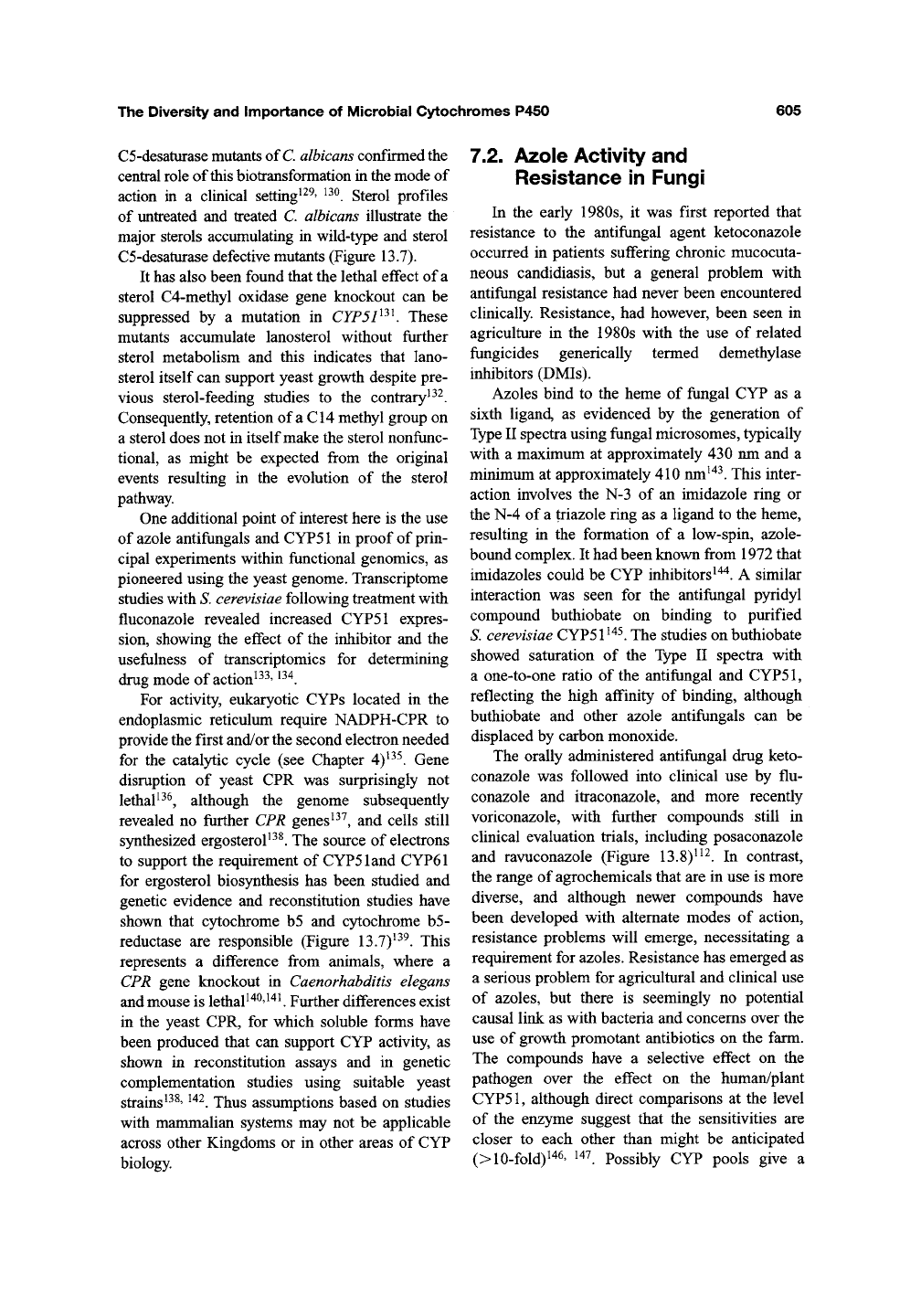
The Diversity and Importance of Microbial Cytochromes P450
605
C5-desaturase mutants of C
albicans
confirmed the
central role of this biotransformation in the mode of
action in a clinical setting^^^' ^^^. Sterol profiles
of untreated and treated C albicans illustrate the
major sterols accumulating in wild-type and sterol
C5-desaturase defective mutants (Figure 13.7).
It has also been found that the lethal effect of a
sterol C4-methyl oxidase gene knockout can be
suppressed by a mutation in CYP51^^^. These
mutants accumulate lanosterol without further
sterol metabolism and this indicates that lano-
sterol itself can support yeast growth despite pre-
vious sterol-feeding studies to the contrary^ ^^.
Consequently, retention of
a
C14 methyl group on
a sterol does not in itself make the sterol nonfunc-
tional, as might be expected from the original
events resulting in the evolution of the sterol
pathway.
One additional point of interest here is the use
of azole antifungals and CYP51 in proof of prin-
cipal experiments within functional genomics, as
pioneered using the yeast genome. Transcriptome
studies with
S.
cerevisiae following treatment with
fluconazole revealed increased CYP51 expres-
sion, showing the effect of the inhibitor and the
usefulness of transcriptomics for determining
drug mode of action^^^'
^^^.
For activity, eukaryotic CYPs located in the
endoplasmic reticulum require NADPH-CPR to
provide the first and/or the second electron needed
for the catalytic cycle (see Chapter
4)^^^.
Gene
disruption of yeast CPR was surprisingly not
lethal^^^, although the genome subsequently
revealed no further CPR genes^^^, and cells still
synthesized ergosterol^^^. The source of electrons
to support the requirement of
CYPS
land CYP61
for ergosterol biosynthesis has been studied and
genetic evidence and reconstitution studies have
shown that cytochrome b5 and cytochrome b5-
reductase are responsible (Figure 13.7)^^^. This
represents a difference from animals, where a
CPR gene knockout in Caenorhabditis elegans
and mouse is lethal
^"^^'^"^^
Further differences exist
in the yeast CPR, for which soluble forms have
been produced that can support CYP activity, as
shown in reconstitution assays and in genetic
complementation studies using suitable yeast
strains^^^'
^^'^.
Thus assumptions based on studies
with mammalian systems may not be applicable
across other Kingdoms or in other areas of CYP
biology.
7.2. Azole Activity and
Resistance in Fungi
In the early 1980s, it was first reported that
resistance to the antifungal agent ketoconazole
occurred in patients suffering chronic mucocuta-
neous candidiasis, but a general problem with
antifungal resistance had never been encountered
clinically. Resistance, had however, been seen in
agriculture in the 1980s with the use of related
fungicides generically termed demethylase
inhibitors (DMIs).
Azoles bind to the heme of fungal CYP as a
sixth ligand, as evidenced by the generation of
Type II spectra using fungal microsomes, tj^ically
with a maximum at approximately 430 nm and a
minimum at approximately 410 nm^"^^. This inter-
action involves the N-3 of an imidazole ring or
the N-4 of a triazole ring as a ligand to the heme,
resulting in the formation of a low-spin, azole-
bound complex. It had been known from 1972 that
imidazoles could be CYP inhibitors
^'^'^.
A similar
interaction was seen for the antifungal pyridyl
compound buthiobate on binding to purified
S. cerevisiae CYPSl^"^^. The studies on buthiobate
showed saturation of the Type II spectra with
a one-to-one ratio of the antifungal and
CYP51,
reflecting the high affinity of binding, although
buthiobate and other azole antifungals can be
displaced by carbon monoxide.
The orally administered antifungal drug keto-
conazole was followed into clinical use by flu-
conazole and itraconazole, and more recently
voriconazole, with further compounds still in
clinical evaluation trials, including posaconazole
and ravuconazole (Figure 13.8)^^^. In contrast,
the range of agrochemicals that are in use is more
diverse, and although newer compounds have
been developed with alternate modes of action,
resistance problems will emerge, necessitating a
requirement for azoles. Resistance has emerged as
a serious problem for agricultural and clinical use
of azoles, but there is seemingly no potential
causal link as with bacteria and concerns over the
use of growth promotant antibiotics on the farm.
The compounds have a selective effect on the
pathogen over the effect on the human/plant
CYP51,
although direct comparisons at the level
of the enzyme suggest that the sensitivities are
closer to each other than might be anticipated
(>10-fold)i46' 147. Possibly CYP pools give a
